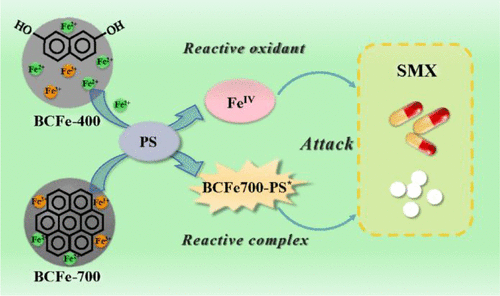当前位置:
X-MOL 学术
›
Environ. Sci. Technol.
›
论文详情
Our official English website, www.x-mol.net, welcomes your
feedback! (Note: you will need to create a separate account there.)
Persulfate Oxidation of Sulfamethoxazole by Magnetic Iron-Char Composites via Nonradical Pathways: Fe(IV) Versus Surface-Mediated Electron Transfer
Environmental Science & Technology ( IF 10.8 ) Pub Date : 2021-07-02 , DOI: 10.1021/acs.est.1c01618 Jun Liang 1 , Xiaoguang Duan 2 , Xiaoyun Xu 1 , Kexin Chen 1 , Yue Zhang 3 , Ling Zhao 1 , Hao Qiu 1 , Shaobin Wang 2 , Xinde Cao 1, 4
Environmental Science & Technology ( IF 10.8 ) Pub Date : 2021-07-02 , DOI: 10.1021/acs.est.1c01618 Jun Liang 1 , Xiaoguang Duan 2 , Xiaoyun Xu 1 , Kexin Chen 1 , Yue Zhang 3 , Ling Zhao 1 , Hao Qiu 1 , Shaobin Wang 2 , Xinde Cao 1, 4
Affiliation

|
Despite the vital roles of reactive radical species in the coupled iron–carbon composite/persulfate (PS) system for eliminating pollutants, nonradical contributions are typically overlooked. Herein, we developed two efficient magnetic iron–char composites via low-temperature (BCFe-400) and high-temperature (BCFe-700) pyrolysis. The two composites activated PS through nonradical pathways for sulfamethoxazole (SMX) degradation. In the BCFe-400/PS system, high-valent iron Fe(IV) was the dominant active species for the oxidation, evidenced by methyl phenyl sulfoxide-based probe tests, Mössbauer spectroscopy, and in situ Raman analyses with kinetic evaluation. In the BCFe-700/PS system, surface-mediated electron transfer dominated the oxidation, and the nonradical regime was probed by the electrochemical test and in situ Raman analysis. Furthermore, the BCFe-400/PS system maintained high efficiency in continuous degradation of SMX due to the feasible Fe2+generation toward Fe(IV) formation. In the BCFe-700/PS system, the stability of the system was limited due to the hindered electron transfer between the surface reactive complex (i.e., BCFe-700–PS*) and SMX, and thermal treatment would help recover the reactivity. Both BCFe-400/PS and BCFe-700/PS systems exhibited high performances for SMX removal in the presence of chloride and humic acid and in real water matrixes (e.g., seawater, piggery wastewater, and landfill leachate), exhibiting the great merits of the nonradical system. Overall, the study would provide new insights into PS activation by iron-loaded catalysts to efficiently degrade pollutants via nonradical pathways.
中文翻译:

磁性铁炭复合材料通过非自由基途径氧化磺胺甲恶唑的过硫酸盐氧化:Fe(IV)与表面介导的电子转移
尽管反应性自由基物质在耦合铁碳复合物/过硫酸盐 (PS) 系统中对于消除污染物具有重要作用,但非自由基的贡献通常被忽视。在此,我们通过低温(BCFe-400)和高温(BCFe-700)热解开发了两种高效的磁性铁炭复合材料。这两种复合材料通过磺胺甲恶唑 (SMX) 降解的非自由基途径激活 PS。在 BCFe-400/PS 系统中,高价铁 Fe(IV) 是氧化的主要活性物质,基于甲基苯基亚砜的探针测试、穆斯堡尔光谱和具有动力学评估的原位拉曼分析证明了这一点。在 BCFe-700/PS 系统中,表面介导的电子转移主导了氧化,并且通过电化学测试和原位拉曼分析探测了非自由基状态。此外,2+代向 Fe(IV) 形成。在 BCFe-700/PS 系统中,由于表面反应性复合物(即 BCFe-700-PS*)和 SMX 之间的电子转移受阻,系统的稳定性受到限制,热处理将有助于恢复反应性。BCFe-400/PS 和 BCFe-700/PS 系统在氯化物和腐植酸存在下以及在实际水基质(例如海水、猪场废水和垃圾渗滤液)中均表现出高性能的 SMX 去除,展示了非激进系统。总体而言,该研究将为负载铁的催化剂活化 PS 以通过非自由基途径有效降解污染物提供新的见解。
更新日期:2021-07-20
中文翻译:

磁性铁炭复合材料通过非自由基途径氧化磺胺甲恶唑的过硫酸盐氧化:Fe(IV)与表面介导的电子转移
尽管反应性自由基物质在耦合铁碳复合物/过硫酸盐 (PS) 系统中对于消除污染物具有重要作用,但非自由基的贡献通常被忽视。在此,我们通过低温(BCFe-400)和高温(BCFe-700)热解开发了两种高效的磁性铁炭复合材料。这两种复合材料通过磺胺甲恶唑 (SMX) 降解的非自由基途径激活 PS。在 BCFe-400/PS 系统中,高价铁 Fe(IV) 是氧化的主要活性物质,基于甲基苯基亚砜的探针测试、穆斯堡尔光谱和具有动力学评估的原位拉曼分析证明了这一点。在 BCFe-700/PS 系统中,表面介导的电子转移主导了氧化,并且通过电化学测试和原位拉曼分析探测了非自由基状态。此外,2+代向 Fe(IV) 形成。在 BCFe-700/PS 系统中,由于表面反应性复合物(即 BCFe-700-PS*)和 SMX 之间的电子转移受阻,系统的稳定性受到限制,热处理将有助于恢复反应性。BCFe-400/PS 和 BCFe-700/PS 系统在氯化物和腐植酸存在下以及在实际水基质(例如海水、猪场废水和垃圾渗滤液)中均表现出高性能的 SMX 去除,展示了非激进系统。总体而言,该研究将为负载铁的催化剂活化 PS 以通过非自由基途径有效降解污染物提供新的见解。































 京公网安备 11010802027423号
京公网安备 11010802027423号